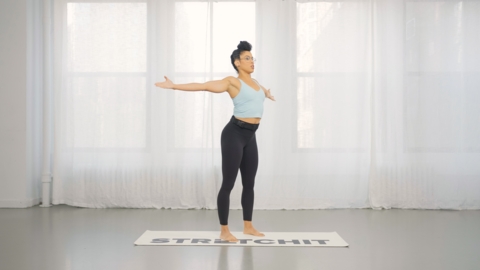The Importance of Rest and Recovery to Optimize Your Health and Flexibility Goals
Whether you’re aiming to master the splits, about to embark on a transformative 90-day fitness challenge, or using stretching exercises to alleviate low back pain, achieving your goals involves more than just pushing your limits in training.
Reaching your flexibility, fitness, and health goals involves understanding the significance of two often overlooked elements of wellness: rest and recovery. These are vital to your efforts in the gym or on the mat, playing a crucial role in achieving and maintaining your results.

No amount of practice alone will make you a better athlete, but rather how your body reacts to your training efforts.
Whether you're pushing your limits with a personal fitness trainer near you, doing STRETCHIT classes online, or flowing through asanas on your yoga mat, you're engaging in an activity that imposes heavy demands on your body and mind.
And pushing your limits requires sufficient downtime for your body to rejuvenate and thrive.
Think of your health and fitness as a bucket of water. A fuller bucket means a higher level of overall well-being. When your bucket is full to its brim, you’ll get out of bed with energy, have a sharp focus at work, and give your best in each workout. Simply, your body and mind feel great.
But with each workout, a bit of the water splashes out. The more intense your training effort, the bigger the splash. The intensity is not just tied to high heart rate or muscle burn, but also to pushing your limits in flexibility training.
If the water level in the bucket gets too low over time, you’ll start to notice the negative symptoms of pushing your body a bit too hard.

Signs that you’re lacking in rest and recovery
- Low in energy
- Brain fog
- Getting sick often
- Constant soreness
- Negative thoughts
- Lack of self-control about emotions, eating, and job practices
For ideal health, and to make the most out of your workouts, you want to refill the less-than-full bucket as soon as you’ve splashed water out of it. And the only way to fill your bucket is by prioritizing rest and recovery.
The role of rest in flexibility and overall health is about allowing your body to replenish energy and repair tissues. Unsurprisingly, sleep is paramount in this process. Sleep helps your brain consolidate muscle memory, relax the nervous system and stimulate the release of growth hormones essential for muscle repair. All of these are important for improving your flexibility, fitness, and health.

Although ice baths, infrared saunas, and the like are in vogue for better recovery, the quantity and quality of sleep matter the most. Followed by nutrition that supports your health and training goals and stress management techniques that help you deal with the incoming mental stress.
The role of recovery in flexibility and health recovery includes methods like low-intensity workouts on rest days as part of your routine. Whether you're involved in a 90-day fitness challenge or doing one of our 60-day split challenges, active recovery might involve:
- A gentle walk or cycling
- Light stretching and flexibility work
- Breathing exercises
- Other activities that keep your heart rate low and help calm your nervous system
If you’re struggling with back pain, recovery could also focus on restorative back pain relief exercises like thoracic rotation or cat camel. Recovery also includes activities like:
- Meditation and breathing exercises
- Getting a massage
- Using saunas and ice baths, as mentioned earlier
And occasionally, the best form of recovery is complete rest.

Combining flexibility, rest, and recovery for optimal results strike a balance between physical activities and adequate rest and recovery, here's a three-step approach:
- Prioritize sleep, nutrition, and stress management for 7-9 hours of sleep each night, eat to support your flexibility, health, and fitness goals, and limit or manage the incoming psychological stress. These three form the foundation for your recovery.
- Schedule recovery days. Recovery days should be as much a part of your 90-day fitness challenge and flexibility goals as your workout days are. You can include walking, cycling, or other low-heart-rate cardio exercises while keeping your heart at around 70% of its max.
- Gentle stretching. A relaxing flexibility routine on your rest days can aid recovery. And if you’re dealing with back pain, you can include back pain relief exercises in your regimen. There are plenty to choose from in the STRETCHIT app.
Always strive for a sustainable routine – pushing to exhaustion may result in burnout or injuries. Aim for a balanced program you can follow in the long term, embracing fitness, flexibility, rest, and recovery. Think about your progress in weeks and months, not in days.

Rest and recovery are signs of strength and wisdom they are your allies in reducing the risk of injury, avoiding burnout, enhancing performance, and achieving sustainable progress. As you challenge yourself in fitness and flexibility, it's vital to listen to your body, prioritize rest and include recovery habits as a critical part of your process.
To further aid your recovery and improve your flexibility, include stretching into your routine. Besides challenging and improving your flexibility, The STRETCHIT app can also guide you through recovery workouts or low back pain relief exercises that support your overall health and fitness goals.




